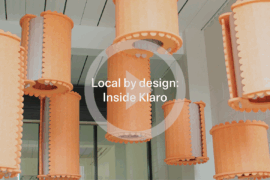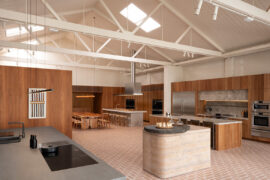How did a German ironworks become a global leader in luxury appliances? We chart innovation through the centuries with Denise Tan, Head of Gaggenau Asia Pacific and Head of Cooking Category.

Gaggenau: A 333 Year History
In 1683, Margrave Ludwig Wilhelm von Baden founded an ironworks in the town of Gaggenau, in Germany’s Black Forest. Named after its hometown, the foundry produced nails and useful metal ware, capitalising on iron ore deposits occurring naturally in the area.
By the late 1800s, this enterprise would eventually herald in the Industrial age, when Gaggenau would begin to make agricultural machinery and tools, as well as manufacturing the Badenia bicycle.
With a growing range of diverse products, Gaggenau honed their techniques to gain unmatched expertise across a variety of specialised production skills.
The company became one of the earliest masters of enamelling, and went on to produce enamel signage for advertising – some of the first commercially made products developed for private enterprise, rather than industrial labour. By the end of the nineteenth century, the focus turned to coal-fire, applying their proficiency in enamel to the fabrication of the earliest gas-powered stoves.
“There’s simply no other luxury brand in the world with so much history!” says Denise Tan, regional head of the brand’s cooking portfolio. “What has been constant is that Gaggenau has been able to continually adapt and cater directly to people’s needs over time.”
Gaggenau survived bombing through both Great Wars to emerge in the 1950s, a time of long awaited homecoming and newfound revelry in domestic life. The world’s first integrated appliances, including a separate cooktop and the built-in wall oven, were released. And with keen home chef Georg Von Blanquet at the helm, Gaggenau’s status at the forefront of kitchen design and cooking technology was cemented.
“Gaggenau plays an important role, because we offer leading technology in a very beautiful package,” says Denise. In fact, the technology is often so advanced that Gaggenau’s broad community of company representatives and culinary ambassadors play a crucial role in educating enthusiastic foodies, designers and home chefs about ways to integrate cooking techniques and equipment previously considered beyond the grasp of everyday life.
Today, with techniques far beyond their early smithing days, the spark is evident in the revelatory brilliance of the unexpected detail.
Named in honour Gaggenau’s 333 years of history, their newly re-designed EB 333 oven remains a culinary icon. At a generous 90 centimetres, it stays true to the original avant-garde design and is still built almost entirely by hand. The new EB 333 brings the standard and functionality of a modern professional kitchen appliance into the home.
“The attention that we give to the little things, I think, is what makes Gaggenau very effective,” says Denise.
Gaggenau introduced the combi-steam oven into the home 15 years ago. The current 400 series appliance is the perfect example of precision, allowing one-degree temperature controls. When used in combination with the 400 series vacuum drawer, this complete system enables sous-vide cooking in the home, a technique that was difficult to recreate outside of the professional kitchen.
“I have just recently managed to cook an entire three-course meal by sous-vide,” says Denise. “It means you can prepare your weekly meals ahead of time while preserving all of the goodness and nutrients – something that I think will really resonate in the future here in Australia.”
Apart from preparing meals for sous-vide, the ability to improve kitchen hygiene and reduce food wastage with the vacuum drawer is another plus, with three levels of oxygen extraction and heat-sealing available. Once sealed, there is minimal risk of bacterial exposure, thus extending the life of fresh produce in storage.
“Each product designed by us is measured to the highest levels of authenticity and quality – we don’t compromise,” says Denise. “We’ve had many successes along the way – but what motivates me is the next 300 years.”
INDESIGN is on instagram
Follow @indesignlive
A searchable and comprehensive guide for specifying leading products and their suppliers
Keep up to date with the latest and greatest from our industry BFF's!

For those who appreciate form as much as function, Gaggenau’s latest induction innovation delivers sculpted precision and effortless flexibility, disappearing seamlessly into the surface when not in use.

In an industry where design intent is often diluted by value management and procurement pressures, Klaro Industrial Design positions manufacturing as a creative ally – allowing commercial interior designers to deliver unique pieces aligned to the project’s original vision.

With the opening of the 2026 INDE.Awards program, now is the time to assess your projects, ensure photography is at hand and begin your submissions.

Former INDE Luminary LeAmon joins the Design Institute of Australia (DIA) following more than a decade as the inaugural Curator of Contemporary Design and Architecture at the National Gallery of Victoria (NGV).

For those who appreciate form as much as function, Gaggenau’s latest induction innovation delivers sculpted precision and effortless flexibility, disappearing seamlessly into the surface when not in use.

The Fisher and Paykel Melbourne Experience Centre by Clare Cousins Architects with Fisher and Paykel Design and Alt Group has been awarded The Retail Space at the INDE.Awards 2025. As a winning project, it redefines the possibilities of retail architecture by creating an immersive, material rich environment shaped by place, culture and craft.
The internet never sleeps! Here's the stuff you might have missed

Located in the former Madam Brussels rooftop, Disuko reimagines 1980s Tokyo nightlife through layered interiors, bespoke detailing and a flexible dining and bar experience designed by MAMAS Dining Group.

Hiwa, the University of Auckland’s six-storey recreation centre by Warren and Mahoney with MJMA Toronto and Haumi, has taken out Sport Architecture at the 2025 World Architecture Festival. A vertical village for wellbeing and connection, the project continues its run of global accolades as a new benchmark for campus life and student experience.